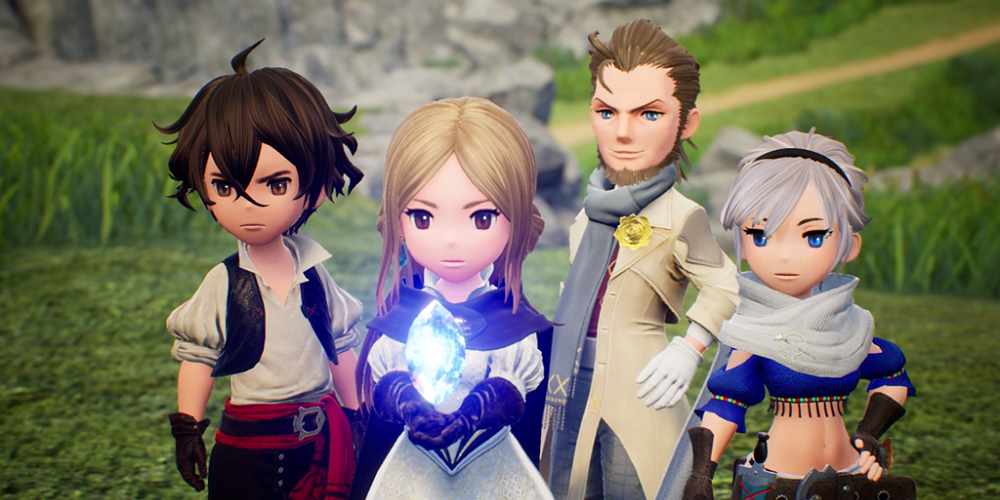Available On: Switch
Played On: Switch
Bravely Default 2 is exactly what I wanted from a sequel to the retro-inspired JRPG series (confusingly, the third game in the series): a stirring soundtrack, fun characters, challenging turn-based combat, and an intricate multi-classing job system that makes the series so compelling. It’s a shame it’s all wrapped within a mostly forgettable, bog-standard JRPG story.
Heroes of Light
Within the first hour of the story we’re introduced to the game’s four protagonists: Seth, the energetic sailor, Gloria, the sincere princess, Elvis the sassy hedonist, and Adelle, the hot-headed mercenary. Like previous games in the series, these four are the only party members in the game, and they’ll be part of my team throughout the 50+ hour adventure. Thankfully it’s a fun group, with lots of in-party banter and solid voice acting (particularly Elvis’ Scottish accent).
That same joy can’t be wrought out of the by-the-numbers JRPG story, however. Taking direct inspiration from older Final Fantasy games, the Bravely Default storyline is little more than an excuse to travel the fantasy world and hunt down four powerful magic crystals, each of which can unlock the special attack for each of our four Heroes of Light.
While there is an overarching villain, most of the story is divided into smaller chapters that cover a specific region. The region includes a central town, several dungeons, and a few notable NPCs that make up that chapter’s storyline. The individual chapter stories aren’t terrible, but neither are they compelling within the larger narrative. Thankfully the combat and job system make up for it.
Grinder’s Paradise
While many RPGs are weary of grinding, Bravely Default 2 embraces it. Each of my heroes has a character level, and a job level. Jobs are earned by defeating prominent villains throughout the main story (with a few unlockable side jobs along the way) and can be freely switched among all four heroes. Jobs run the gamut from the typical fantasy classes(white mage for healing, vanguard for defensive warrior, thief for dexterous fighter) to the more unconventional (gambler uses gold and roulette wheels, beastmaster can capture and unleash enemy attacks).
Each hero can equip two jobs, though only leveling up one at a time, unlocking new skills and attributes with each level. Additionally, every job has a number of passive abilities that can be equipped regardless of the main or sub jobs, leading to a constant discovery of cool synergies and a yearning for maximizing each characters’ potential.
![]() In order to gain that power, we’ll need to grind out some fights. Combat in Bravely Default 2 is entirely turn-based, and focuses around the series’ signature Brave and Default commands. Default is the same as Defend or Guard. In other RPGs it’s almost never used, but here Defaulting greatly reduces damage and generates one Brave Point. At any time a character can Brave to spend BP and gain extra turns, up to a maximum of three. Heroes can even borrow BP and go into the negative, unleashing huge attacks at the cost of missing several future turns. It’s an engaging system that motivates me to pay attention to the flow of battle, and notice when enemies Default, or ready an attack (both of which are clearly displayed).
In order to gain that power, we’ll need to grind out some fights. Combat in Bravely Default 2 is entirely turn-based, and focuses around the series’ signature Brave and Default commands. Default is the same as Defend or Guard. In other RPGs it’s almost never used, but here Defaulting greatly reduces damage and generates one Brave Point. At any time a character can Brave to spend BP and gain extra turns, up to a maximum of three. Heroes can even borrow BP and go into the negative, unleashing huge attacks at the cost of missing several future turns. It’s an engaging system that motivates me to pay attention to the flow of battle, and notice when enemies Default, or ready an attack (both of which are clearly displayed).
To further incentivize battling, Bravely Default 2 includes items that lure certain monster types into repeat battles. By using these items, I can chain several battles in a row, earning additional multipliers of job points. Combined with the ability to see enemies directly on the map, I’m in complete control of when I want to maximize my battles versus avoid enemies entirely during lengthy dungeon crawls.
Normally grinding too much would make the game trivial, but even at normal difficulty a normal battle against random enemies could turn deadly. Though I can see the lead enemy directly on the map, the resulting battle could include a number of enemies from that zone. I’ll need to exploit their weaknesses and keep my team healed even if it lasts only a few rounds. Boss fights are on a whole different level, with some epic battles taking upwards of 15 or even 30 minutes depending on my party makeup, yet never frustrating or unfair.
 The Rating
The Rating
Bravely Default 2 is rated T for Teen by the ESRB, with Mild Blood, Mild Suggestive Themes, Use of Alcohol, and Violence. Combat animations lack gore or blood, and the story is on par with most save-the-world JRPGs, with few shades of grey. Cutscenes can get a bit more violent, however, despite the cartoony art style, and a few of the job outfits and NPCs are overly suggestive.
The Takeaway
I expected a retro-inspired JRPG with a fun, deep combat and job system, and Bravely Default 2 delivers exactly that. I wish the series could break out of the ho-hum magic crystal story. But the art style, character designs, and animations look great on the big screen and in handheld mode, and the soundtrack helps elevate the prolonged yet enjoyable hours I spend grinding out battles and maximizing my team of multi-class disasters.


